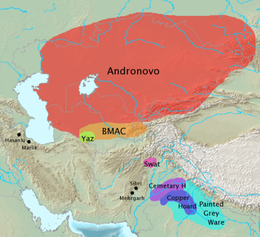Copper hoard culture

The Swat , Cemetery-H , Copper- Hort , and Painted-Gray-Ware cultures are candidates for the earliest Indo-Aryan cultures.

As copper hoards (English Copper Hoards ) are found associations of copper artifacts that are common in northern India. These deposits seem to date to the second millennium BC, although only a few come from controlled excavations that could prove this.
Four regional groups of finds are recognizable: South Haryana and North Rajasthan , the Ganges - Yamuna plain, Chota Nagpur (largely corresponding to today's Jharkland ) and Madhya Pradesh , each with characteristic find types. The copper hoards were known as stray finds as early as the 19th century and are therefore still considered by various authors to be a typical find type for the Mesopotamian North India.
Characteristic hoard finds from South Haryana and North Rajasthan include flat axes, harpoons, double axes, swords with so-called antenna handles, etc. The Doab contains related types. Those from Chota Nagpur are fundamentally different and appear to be copper bars.
The majority of the artifacts appear to be holy objects and show no clear signs of ancient wear. The copper ore comes from different areas in Rajasthan ( Khetri ), Bihar , West Bengal and Orissa (especially Singhbhum ) as well as Madhya Pradesh ( Malanjkhand ).
literature
- Paul Yule : The Bronze Age Metalwork of India (= Prehistoric Bronze Finds XX, 8). Munich 1985, ISBN 3-406-30440-0 .
- P. Yule, A. Hauptmann, M. Hughes: The Copper Hoards of the Indian Subcontinent: Preliminaries for an Interpretation . In: Yearbook of the Römisch-Germanisches Zentralmuseum Mainz , Volume 36, 1989 [1992], pp. 193-275, ISSN 0076-2741 .
- Paul A. Yule: A New Prehistoric Anthropomorphic Figure from the Sharqiyah, Oman . In: C. Lamberg-Karlovsky, B. Genito, B. Cerasetti (eds.): "My Life is like the Summer Rose". Maurizio Tosi e l'Archeologia come modo di vivere. Papers in Honor of Maurizio Tosi on his 70th Birthday (= BAR Intern. Series 2690). Oxford 2014, pp. 759-760, ISBN 978-1-4073-1326-9 .
Individual evidence
- ↑ James P. Mallory, Douglas Q. Adams (Ed.): Encyclopedia of Indo-European culture. Fitzroy Dearborn Publishers, London and Chicago 1997 ( digitized as PDF document [194 MB] ).